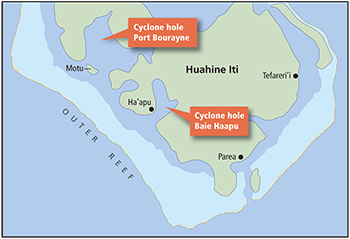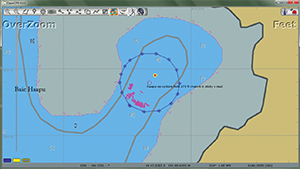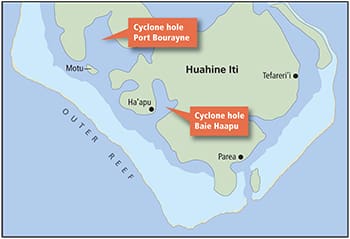 |
|
Two cyclone holes on Huahine Iti, one at Port Bourayne and another at Baie Haapu. |
Deciding to stay in the Society Islands meant finding a suitable hurricane hole. Would the hurricane holes in Tahiti Iti or on the small island of Huahine Iti, 100 nm to the north and west of Tahiti, provide adequate shelter in a Category 3 or heavier cyclone? That depends on the exact track of the cyclone and whether those hurricane holes become overcrowded with other vessels trying to escape more exposed anchorages.
On the island of Tahiti Iti, Port Phaeton offers a large, excellent, sticky mud bottom in 25 to 45 feet of depth. The problem with Port Phaeton is that everyone in Tahiti will migrate there in the event that a cyclone is forecast. This could create close-quarters anchoring with increased scope and therefore increased swinging room. The marinas in Tahiti and Moorea are not places that we think would fare well in a direct strike.
The island of Huahine Iti, on the other hand, is protected by a moderately deep lagoon that circles the island like a protective moat. Inside that moat there are two protected bodies of water, Port Bourayne and Baie Haapu, one nautical mile inside the outer reefs. At the entrance to Port Bourayne is a motu, a low-lying islet, which itself is surrounded by a reef and shoal water to further break up storm surge. In addition, Port Bourayne is surrounded by low mountains on all sides that form a protective bowl. The elimination of severe waves and surge is a huge asset of both locations. High-wind loads will stress the ground tackle to the limit, but without waves to contend with, a boat has a chance.
The other positive benefit of the Huahine Iti cyclone holes is that the bottom is not silty or fouled with coral; it is composed of volcanic mud and sand, which offer excellent holding. In addition, there’s a lack of competition on Huahine Iti for a protected anchorage. The hurricane holes are big enough to accommodate the few boats that are there. The catch is the deep water. To anchor requires a lot of chain/rode for adequate scope of 7:1 to 10:1 in storm conditions. We have surveyed the bottom with our depth sounder and found that the only suitable locations for anchoring without the potential for dragging onto a shallow shelf (less than 6 feet) are in deep water with a level bottom of about 80 to 90 feet on average. This translates to needing 600 to 900 feet of anchor chain/rode in Port Bourayne.
 |
|
Baie Haapu where Rich and Cat Ian-Frese anchored their boat Anna. The magenta shows where Anna swung in 60 knots of NE wind. |
In Baie Haapu, less chain is required as the average maximum depth is about 45 to 50 feet (about 500 feet of rode would be required for a 10:1 scope). But it’s not always possible to drop this much scope if the swinging room of a boat is limited by shoal water on the sides. This is the case in Baie Haapu in the northeast finger where the inlet narrows. It’s possible to let out 280 feet of chain in 50 meters of water over very sticky mud and get a 5.5:1 scope. We felt that this would be okay and managed to ride out gusting conditions of 60 knots without dragging.
Mathematically, it can be shown that the effects of scope, i.e., catenary, improve as the water gets deeper. For example, all things being equal, an all-chain anchor rode set in 15 feet of water requires a 10:1 scope for the same holding power as an all-chain rode set in 60 feet of water with a scope of only 5.6:1, given the same parameters for the example boat of wind force, anchor type and chain diameter. Deep water works in your favor if you don’t carry massive lengths of chain and nylon rode for excessive water depths. More scope (up to about 10:1) is always better than less scope (3:1), in regards to holding power, but in deep-water anchorages of about 70 to 90 feet, you may be able to manage with less scope than ideal if necessary. This can be an advantage in a crowded deep-water anchorage or when you don’t have enough chain/rode for a 10:1 scope in an anchorage that is protected from waves. You might get by on 5:1 or 6:1 in a lower-category cyclone.
Cyclones aside, Huahine offers a choice of anchorages that will be suitable for almost any conditions. Some of the anchorages have strong mooring balls that you can tie to as well at no additional cost. All the anchorages are protected by a barrier reef and some are protected even further, as discussed, by a protective bowl of low mountains and motus. Another advantage to Huahine is its easy access to shore, where excellent dinghy docks and fresh water are available. There is a very good local supermarket and fuel station in the main town of Fare, at the northwestern end of the island. Internet access is possible in two locations on the island, and this provides access to up-to-date critical weather information. The island’s waters are some of the cleanest and most beautiful of any we’ve ever seen. And the water temperature is ideal, so a casual swim around the boat at anchor makes cleaning the undersides practical and almost enjoyable.
The sail to Huahine from Tahiti was about one full day — a rolling downwind sail through the night, but worth the effort. Getting back to Tahiti or Moorea would be a more difficult task under sail, and would require a wind shift to the north for a downwind rhumb-line ride. The waves are weird and somewhat confused in this area, so it would be best to time the run when the wind and waves were synced — that is, coming from the same direction, preferably from the north if headed southeast from Huahine to Tahiti. The prevailing direction for wind out of Tahiti is east by south with a southwest swell and this creates lumpy rolling conditions, especially when the wind waves meet the swell on the opposing aft quarter in a moderate breeze.

